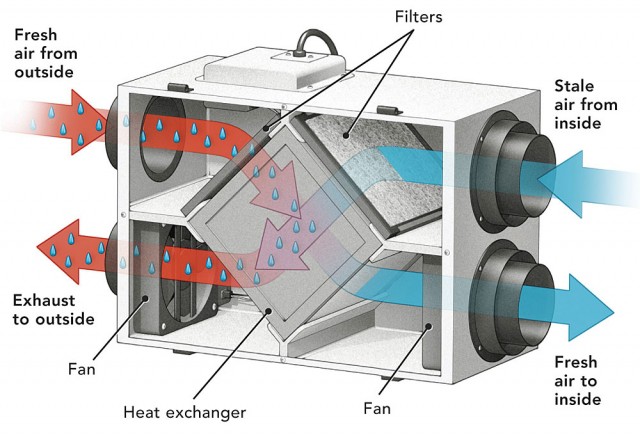How HRV Stabilizes Indoor Humidity
Discovering the Perks of Heat Recovery Ventilation for Energy Efficiency in Houses
Heat Recovery Ventilation (HRV) systems offer house owners a practical method to boosting energy efficiency. By recovering warm from outbound air, these systems can substantially minimize heating & cooling prices. In addition, they give a consistent supply of fresh air, improving interior air quality and comfort levels. As house owners consider lasting options, understanding the nuances of HRV systems ends up being increasingly crucial. What variables should one evaluate before making such an investment?
Comprehending Heat Recovery Ventilation Equipments

Exactly How HRV Boosts Indoor Air Top Quality

Energy Savings: The Financial Advantages of HRV
Maximizing energy efficiency, heat recovery ventilation (HRV) systems provide significant monetary advantages for homeowners. By recouping and reusing warm from exhaust air, HRVs considerably minimize heating & cooling costs. This technology can lead to power financial savings of up to 30%, relying on environment and usage patterns. Property owners commonly observe minimized utility expenses soon after installation, making HRVs a financially wise financial investment with time. Additionally, numerous regions provide motivations or refunds for energy-efficient upgrades, even more enhancing the monetary charm. As energy costs proceed to rise, the cost-effectiveness of HRVs comes to be significantly clear. On the whole, the incorporation of HRV systems image source not just promotes power effectiveness but likewise adds to long-lasting financial cost savings for homes.
The Environmental Influence of Heat Recovery Ventilation
A substantial environmental benefit of heat recovery ventilation (HRV) systems depends on their capacity to minimize total energy intake. By reclaiming warm from exhaust air and transferring it to incoming fresh air, HRV systems reduce the requirement for energy-intensive heating and cooling down methods. This reduction in power need adds to lower greenhouse gas discharges, as much less nonrenewable fuel source is needed to keep comfortable indoor temperatures. In addition, HRV systems boost interior air top quality by efficiently trading stale air with fresh exterior air, reducing dependence on mechanical air conditioning systems that can hurt the setting. Generally, the execution of HRV systems sustains lasting living techniques and aligns with global initiatives to deal with environment change by promoting power efficiency in residential setups.
Picking the Right HRV System for Your Home
Exactly how can home owners ensure they select the right heat recovery ventilation (HRV) system for their requirements? They should assess their home's size and format, as these variables affect airflow demands. Next off, assessing the system's efficiency rankings is important, as greater ratings suggest better performance and power financial savings. Homeowners must additionally take into consideration installment and upkeep costs, comparing different brand names and versions for value. Furthermore, it is essential to review noise degrees, as some systems run more quietly than others. Consulting with cooling and heating specialists can provide tailored referrals based on certain home problems. Examining user reviews and service warranties can aid in making an educated choice, guaranteeing that the chosen HRV system properly enhances indoor air high quality and power efficiency.
Often Asked Inquiries

Exactly how Often Should I Clean or Preserve My HRV System?
The frequency of cleansing or keeping a heat healing air flow (HRV) system usually depends upon use and ecological elements. Usually, it is a good idea to perform upkeep every 6 months to ensure peak efficiency and air high quality.

Can HRV Equipments Help Minimize Moisture Degrees Inside Your Home?
HRV systems can properly decrease interior moisture levels by exchanging stale, reference moist air with fresh, drier air from outside. HRV Heat Recovery Ventilation. This process aids maintain a well balanced interior environment, boosting comfort and protecting against moisture-related concerns
What Is the Life expectancy of a Normal HRV System?
The life-span of a normal heat recovery ventilation (HRV) system differs, generally lasting in between 10 to 15 years. Routine upkeep can expand its effectiveness and operational life, ensuring peak efficiency throughout its use period.
Are There Any Type Of Sound Worry About HRV Equipments?
Noise concerns with HRV systems can occur, especially from fan operation. Several modern-day devices are designed to reduce audio degrees, guaranteeing they run quietly while keeping performance, which addresses prospective disturbances in living settings.
Can I Install an HRV System Myself, or Do I Required an Expert?
The private contemplated whether to mount the heat recovery ventilation (HRV) system personally or work with an expert. Usually, while DIY installment is possible, know-how guarantees proper capability and conformity with local structure codes, improving system performance.